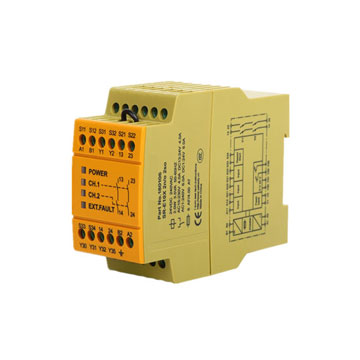How to Use a Safety Relay?
When the operation time and reset time of safety relay changes, whether it would cause malfunction on the circuit shall be specially notified, particularly, when the power supply circuit is also different. The safety relay performs certain control functions through its "connection" and "disconnection", contact system failures usually include contact overheating, wear and fusion.
Main causes of contact overheating are insufficient capacity, insufficient contact pressure, oxidation or uncleanness on the surface. Main causes of wear aggravation are lower contact capacity or oxidation of contact metal caused by high arc temperature. Main causes of contact fusion are high arc temperature or serious contact jitter. Contact of the general safety relay can be maintained by the following order:
Open the cover and check the contact surface. If the contact pressure is not enough, adjust or replace the spring to increase the pressure. If it still fails, replace the contact. Contact should be replaced if fused. If it's caused by small contact capacity, replace with a relay of larger capacity. If the contact surface is not clean, clean with gasoline or carbon tetrachloride. If the contact surface is oxidized, no maintenance needs to be implemented on silver contact, but for copper contact, a dead smooth file can be used to polish its surface or remove the surface oxide layer with a knife. If the contact surface is burned out, no maintenance needs to be implemented on silver contact, but for copper contact, a dead smooth file can be used to polish its surface or remove the surface oxide layer with a knife. Abrasive cloth or sandpaper are not allowed, otherwise sand may be left to cause poor contact.
Safety relay is mainly operated by following steps:
Measure the contact resistance, measure the resistance between normally closed contact and movable contact with the resistance band of a multimeter, corresponding resistance shall be 0 (the contact resistance can be measured within 100 millieu in a more precise way), but the resistance between normally open contact and movable contact shall be infinitely great. On this basis, the normally closed contact and normally open contact can be distinguished.
Measure coil resistance, resistance of a power relay coil can be measured with the R×10Ω band, thus judging whether the coil has open circuit. Measure actuation voltage and actuation current, with an adjustable stabilized voltage supply and ammeter, the power relay can be input with a voltage while the ammeter can be connected in series to monitor. Slowly increase the power supply. Voltage and record the actuation voltage and actuation current when the power relay is attracted. For accuracy, more operations can be repeated to get the average value. Measure release voltage and release current, connect wires as the test above. When the power relay is attracted, reduce the power supply voltage slowly and record the voltage and current as hearing the relay to release again. More operations can be repeated to get the average value.
Actually, if the relay is selected by the following five general steps, the release voltage of power relay is about 10~50% of actuation voltage. If the release voltage is too small (less than 1/10 of the actuation voltage), the relay can't be normally used, otherwise it may hurt the circuit stability.

